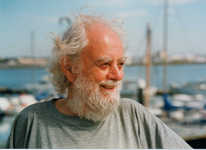Geoffrey Blundell
20th September 1923 to 15th January 2003

Explorations in radar and messages from the brain
Michael Strutt
Tuesday February 11, 2003
The Guardian
The electronics engineer Geoffrey Blundell, who has died aged 79, developed radio microphones that are used worldwide in filmmaking and broadcasting, worked with John Logie Baird and met the Maharishi Mahesh Yogi. During the second world war, he worked on the key RAF radar component, the cavity magnetron, and later developed the mind mirror to measure brain patterns among healers, meditators and gurus.
Blundell's first microphones - allowing performers to move without cables
or booms - used radio valves, since transistors did not become available
until
the mid-1960s. By 1997, amidst the rising waters of the film Titanic, they
withstood studio action for six months.
Blundell was born in Studley, Warwickshire, one of four children of a production
engineer. He was educated at his local grammar school and at Ratcliffe
College, near Leicester, where he made crystal sets for other boys to ensure
their
secrecy about his own use of the primitive radios. At the age of 17, he
joined EMI,
where, as a design engineer, he worked with Logie Baird.
Then came his war work on the magnetron, which was used on Bomber Command's
target location system, H2S radar. In the 1950s, he made amplifiers and
tuners for the hi-fi industry. In 1963, he started Audio Ltd, breaking
through in
1968 when Audio microphones were used on Stanley Kubrick's film, 2001:
A Space Odyssey.
During the pre-Thatcher years, only two or three people at Audio were
electronic experts. When hiring staff, Blundell often chose someone
who played an
instrument or wrote poetry. But he was good at spotting potential,
trained people well
and did not neglect the cash flows.
Then, in the early 1970s, came a collaboration that changed his life.
He accepted a friend's invitation to join a course in biofeedback,
the electronic
monitoring
of physiological responses, being run by Maxwell Cade, a former government
physicist, and his wife Isabel. Intrigued, Blundell suggested he
could design improved monitoring devices, and produced a meter that enabled
students to
monitor improvements in the flexibility of their autonomic nervous
system. He then designed a replacement for the one-channel EEG (electroencephalograph),
and other devices.
In part, the courses were a test laboratory for Cade's research with
Dr Ann Woolley-Hart, of St Bartholomew's hospital, into altered
states, including
deep relaxation, aimed at helping cancer patients. But to carry
the work further - and study the relationship between the alpha, beta,
delta and
theta
rhythms
of each brain hemisphere - they needed a portable brainwave analyser,
an EEG machine that could display the rhythms simultaneously.
Blundell produced his first mind mirror EEG machine in the mid-1970s.
It showed that, as suspected, students achieving states of deep
relaxation were producing
particular combinations of brainwave patterns as both brain hemispheres
synchronised. One of these combinations had pronounced alpha
rhythms, and
Cade, who had
studied eastern philosophies, called it state 5, claiming it
was the pattern of the
awakened mind.
Blundell and Cade began regular research with prominent British
healers and, using two mind mirrors, found that when the healer
directed
healing energy
through their hands to a client, the healer produced a state
5 pattern, and induced a similar one in the client. It was
a spiritual
search
which led
Blundell to an audience with the Beatles' guru, the Maharishi
- though, bemused by the
experience, all he could recall was '"the pink froth emanating from his
lips".
In 1975, Blundell joined Britain's Tibetan Buddhist DzogChen
community, and became a pivotal member. In 1988, with his
second wife, Helen
Stapleton, he travelled with the group in a 90-strong caravan
to western Tibet.
Blundell's approachable manner and thirst for knowledge made
him many friends among people in the experimental arts.
Illness from
2000 forced
him into
near retirement, but he was given devoted care by his friends,
and by Helen, from
whom he had separated. He diligently helped to resolve
the pre-production problems of the last microphone he designed.
His wife
survives him.
•
Geoffrey Gordon Blundell, electronics engineer, born September 20 1923; died
January 15 2003.